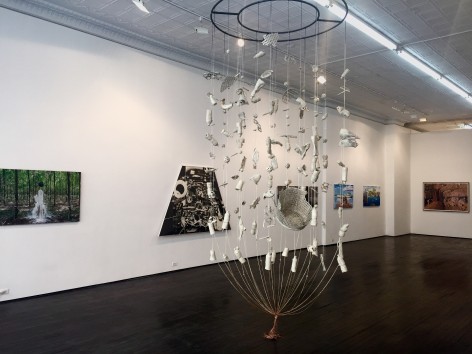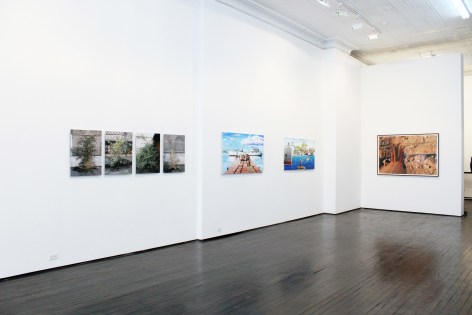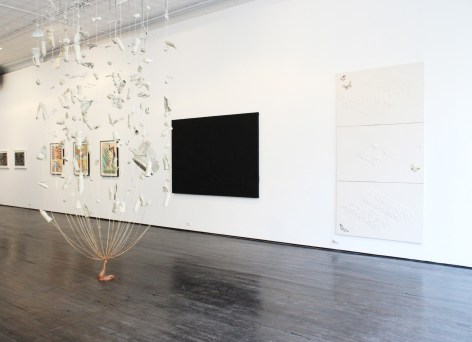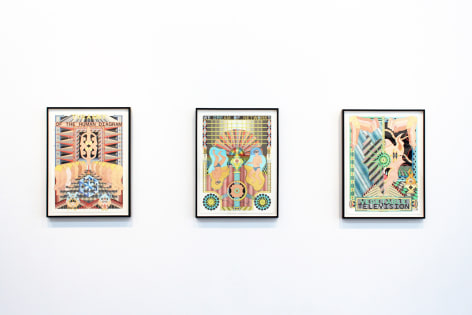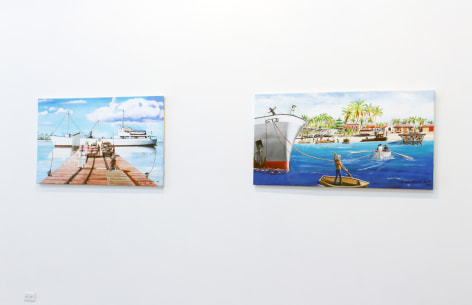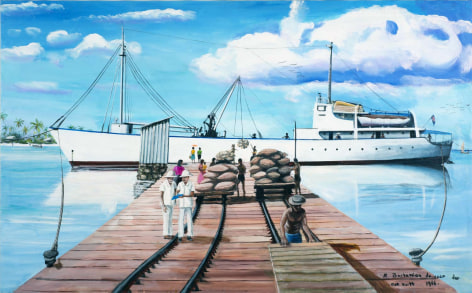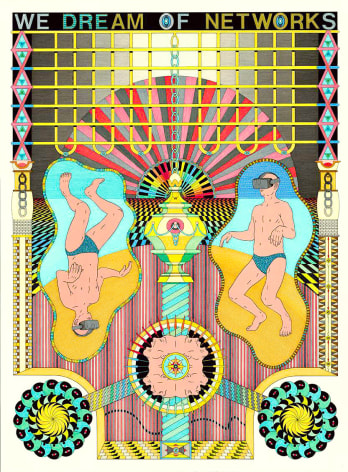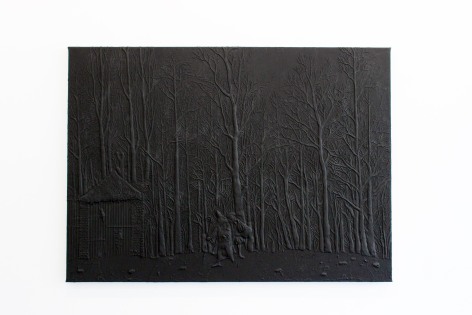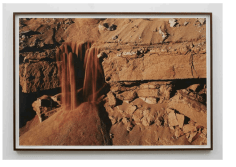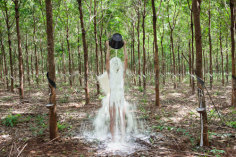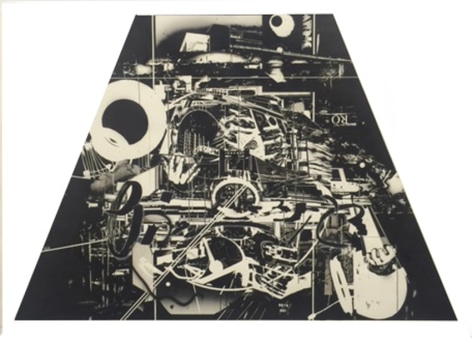April 21 to May 22, 2016
Opening Reception:
April 21, 6-8pm
Exhibiting Artists:
Edgardo Aragón
Michael Assiff
Jess Johnson
Marie Lorenz
Mathieu Pernot
Thiago Rocha Pitta
Khyay Samnang
Clement Siatous
Hiroki Tsukuda
Jack Hanley Gallery is pleased to present Future Nature, a group exhibition probing the current state of the world in a post-natural age and the implications for the future. Rather than an apocalyptic demise by technology as E.M. Forester predicted in “The Machine Stops,” nine artists present questions of land use, citizenship, migration, and political action. Through their interventions for Future Nature, Edgardo Aragón, Michael Assiff, Jess Johnson, Marie Lorenz, Mathieu Pernot, Thiago Rocha Pitta, Khvay Samnang, Clement Siatous and Hiroki Tsukuda each explore an imagined, alternate reality as a result of mankind’s interruptions in nature.
Clement Siatous’s two paintings of life in the Chagos Archipelago are instantly seductive with their bright, beachy palette and calm waters that fill half the canvas. Like a cinematic film still, the skies are filled with endemic and plentiful palm trees set against pristine sand in “Diego Garcia Katalina sur zil,” and bushy clouds reflected in the pristine water and dock in “R barkossion de copra sur la mer dan Diego Garcia.” These two paintings luxuriate in warmth and an annoyingly idyllic landscape, begging you to ignore the comically large freighter ship whose tethering ropes zoom to the foreground where we encounter a shirtless laborer. In fact, every person in the painting is abuzz with purpose, indicating the booming copra and fishing industry of Chagos, a far cry from an imagined Island life. Through his complex acrylic paintings, Siatous masterfully conveys the insulting history of a forgotten people, caught in the political cross-fires and perennially marginalized because of their advantageously situated island. After being discovered by the Portuguese explorer, Chagos was populated by the French, who transformed Diego Garcia, the largest island in the Chagos Archipelago with an advantageously deep lagoon, into a series of plantations and the nexus of their slave trade. The Archipelago was surrendered to the English who used it as a re-fueling station and minor base for their Royal Navy, as evidenced in “Diego Garcia Katalina sur zil,” which depicts a famously damaged and beached Catalina aircraft from 1944. As if to rub salt in the proverbial wound, by 1950, the English then began colluding with the United States who were in need of “an uninhabited island” in the Indian Ocean where they could build their own Naval Base. “R barkossion de copra sur la mer dan Diego Garcia” is set in 1966 when the United States executed an agreement with the British to lease the land for 50 years (through December 2016) and the year before all plantations were systematically closed and residents of Diego Garcia were forcibly expelled without compensation.
In claiming that a permanent population never existed in the Chagos Islands, The British government repeatedly trivialized and ignored the Chagossians, facilitated by the sparse photographic evidence and minimal documentation of their heritage. Continued appeals and hearings to return to their homeland have been perpetually overlooked and verdicts postponed. Recently there have even been attempts to keep out the Chagossians by turning the polluted lagoon into a natural reserve. As a poignant counterpoint to the methodical abuse by Allied Powers, Siatous does not ignore or glamorize any aspect of its sordid history and grounds each canvas with a historically significant date and title in what he calls “a political act,” celebrating a much longed for life in his hometown of Diego Garcia and a hopeful vision for the future.
Much like Clement’s work, Khvay Samnang’s multimedia presentation of “Rubber Man” responds to the colonial legacy of land use and its effects on the indigenous population. Samnang’s deeply poetic video and film stills comment on the increasing deforestation and privatization of land in Cambodia's northeast highland province of Ratanakiri. When the French brought hevea (rubber tree) seeds from Brazil to Indochina, rubber tree plantations became central to the Cambodian’s mythology. The diverse indigenous population ties the worship of their ancestral spirits with the elaborate subsistence cycle of planting, transplanting, harvesting, and regeneration. In Future Nature, Samnang’s video and accompanying two film stills problematize the impact of unrestrained economic growth and reckless exploitation of natural resources on Cambodian ecosystem and social life with calm, elegant resistance and intentionally futile gestures. The artist’s work questions where the spirits will live when the ancient forests and communal lands are lost to private cash crops.
Michael Assiff’s work also tackles the dichotomy of man’s use and exploitation of nature. It focuses on an imagined and yet historical nature. Henri Rousseau’s large paintings with plentiful foliage and vegetation fascinated Assiff, as Rousseau painted repeating flora and fauna while living in a rapidly urbanizing city and yet had never been to the jungle. Assiff translates the luscious exoticism of Rousseau’s original paintings into a thick, almost bas-relief plasticity and removes the figures and animals to create an aestheticized deforestation as visible in “Untitled (Exotic Landscape).” The artist explores the deeply political undertones of colonialists’ aspirations for the exotic untapped wealth of indigenous peoples in “Untitled (African Grey),” which depicts a mythical Dutchmen traipsing through colonized Africa. By contrasting a plentiful wall of foliage with the plastic synthetic coating he uses to meticulously cover the surface, the artist hopes to show how the natural ecosystem remains an instrument of human utility.
Just as Rousseau only painted a nature he imagined, Assiff’s “Untitled (Conventional)” is taken from Farmville, the farming simulation game where users can create their own alternate reality from the safety and comfort of their home. In this work, Assiff creates a classical molding of identical, plump and penned pigs that have been digitally raised for simulated slaughter. Through his tactile and inventive work steeped in dark humor, Assiff illustrates mankind’s proclivity to fetishize, reduce and exploit the environment, making every effort to avoid actual interaction.
Edgardo Aragón’s multimedia practice also highlights the systematic geo-political, financial, social and developmental injustices that perpetually plague a region. In Aragón’s case, his work responds to such issues in his native Mesoamerica, the cradle of Mayan, Aztec and Zapotec cultures. While instrumental to the development of modern society, this region has become a hot-bed of cartel-related violence and corruption. For Future Nature, Aragón presents two hand-drawn maps with elaborate coloring, entitled “Mesoamérica: Grandes Civilizaciones,” as a critical cartography to reveal the power structures in Mexico. The first map bears a large red 43 and depicts large mythical beasts representing the parties involved in the disappearance of 43 students from the University of Ayotzinapa just outside of Acapulco on 26 September 2014. As is common practice of demonstrating students in Mexico, they hijacked a bus to attend a protest, but they were pulled over upon reaching the Chipote bridge. The local police shot the tires, broke the bus windows with rocks and sticks and finally shot Tear gas into the bus until the students exited and were loaded onto police patrol trucks. Although two federal police arrived on the scene, they did not interfere. The remaining students were then loaded into a second police vehicle from another town never to be seen or heard from.
Aragón’s cartoonish and child-like representations of the responsible parties, calls attention to the optimistic outlook of the student protesters who have been missing for two years. The red region on the first map calls attention to the site of the sordid disappearance which the federal attorney refuses to investigate and also connects with the highlighted pathways from South and Central America to North America in Aragón’s second map. This map’s red network highlights the infamous route of the “Tren de la muerte” or “La Bestia” meaning the Train of Death or the Beast. Roughly half a million migrants annually from all parts of Southern and Central America ride atop freight trains to traverse Mexico in hopes of reaching America. Hugely dangerous with innumerable fatalities and horrific injuries, migrants are consistently raped, assaulted and robbed. Aragón’s thoughtful maps highlight the north and south in the same color with a nexus between the two, demonstrating both a visual and a cultural interconnectedness that is often overlooked.
Aragón’s visual representation of flow of discriminated immigrants is echoed in Marie Lorenz’s exploration of urban waterways and the celebration of cast aside human matter. She finds beauty in the debris that accumulates at the base of harbor pilings and wash ashore. An avid marine explorer, Lorenz builds boats to navigate urban waterways and relishes the unexpected array of flotsam brought in by the tides. Her installation entitled “Vessels” is comprised of cast water bottles, plastic jugs, Styrofoam cups with a plastic basket at the center. The dramatic web of life-sized white ceramic detritus are delicately strung on cords which issue from the ceiling and are tied together at the base. Lorenz’s beachcombing is a solitary venture with little to no human interaction yet the debris is a clear indication of recent human presence. In an eerie way, this impressive cornucopia of fossilized debris serves as a record of human presence as if after an apocalypse.
Thiago Rocha Pitta also investigates human impact through his intense study of the alchemical properties of nature. The artist stages small interventions in nature that force an entrophic but natural process. In “Temporal maps of a non sedimented land #1,” Rocha Pitta causes desert soil in Argentina to spill over the edge of a cliff, much like sand in an hourglass. While beautifully photographed as if a National Geographic spread with muted colors, the captured erosion is far from a naturally occurring phenomenon to celebrate, and instead is a man-made effect that is destructive. Rocha Pitta shows that maps cannot capture the catastrophic results of human activity on nature and the ongoing effects of time.
Executed in charcoal and meticulous ink, Hiroki Tsukuda’s “Astrophobia” uses forced perspective to collapse space and futuristic machinery to render an “outer world.” Growing up on the Shikoku Island in Japan, the artist would imagine possible cityscapes that lay beyond and upon moving to Tokyo, was inspired by the bustling metropolis’ architecture. The artist uses a computer to painstakingly blend images from his own collection with those he finds online. He then draws the combined product in ink and charcoal, adding hints of gestural paint to “complete the monochromatic images of worlds within worlds.” Colorblind, Tsukuda works predominantly in vertiginous black and white, creating a highly defined graphic realism and skillfully mashing-up dystopian iconography, science fiction and popular video games. These futuristic and fragmented landscapes create an alternate world devoid of humans that is particularly poignant in the highly mechanized, digital world of today.
Much like Tsukuda’s imagined alternate environment, Jess Johnson’s optical, graphical explorations envision a dystopian space. In “Tyranny of the Human Diagram,” repeating figures are bent over subserviently with the supportive structure of a cube in the center. Masks reminiscent of Aztec or Celtic demigods flank the lower edge. The fastidiously rendered complex drawings merge 1980’s video games with a very sophisticated spatial awareness. The central figures have intertwined four-part braids issuing from their mouths beneath the block letters of Tyranny of the Human Diagram.
Johnson is particularly intrigued by the notion of “world-building.” Her three colorful works for Future Nature, are like hypnotic rock posters with their flattened perspective and inviting fantasy world of astral planes. “We Dream Of Networks,” has limp floating figures absorbed in an amoeba, wearing simulation goggles. A decadent gate is half-drawn and from it hangs a decorative vase atop a pedestal. In this mind-twitching alternative virtual reality, the artist aims to show “architectural monuments’ of some alien civilization and are populated with contorted humanoid figures and bat-faced aliens.” We are taught to think that reality is fixed, but Johnson approaches it as a multidimensional and ever-changing. Her works for Future Nature explore the bounds of technology and multiple futures, and through her non-threatening virtual reality, we have a connecting force through which we can dissolve boundaries.
Mathieu Pernot’s work is equally interested in the dissolution of boundaries. The artist's deeply moving photographs respond to the inequality of our contemporary world. Inspired by the intellectual legacy of French philosopher activist Michel Foucault, his photographs bear witness to fringe architectural spaces and the marginalized populations who reside in them. Crumbling social housing projects, panoptic prisons, psychiatric asylums, nomadic communities of migrants and gypsies-these are the recurrent subjects of Pernot’s oeuvre. For Future Nature, he presents a series of photographs of cold, foreboding prison yards. This area of confined freedom for the inmates is also a place of absolute surveillance. Yet these metal fences and concrete buildings are interrupted by the anarchic sprouting of invasive plants, demonstrating the ability of nature to thrive in the most inhospitable environments -- a metaphor for the pervasion of mankind’s spirit in the least inviting of spaces.
As mankind wrestles for constant control over nature through deforestation, development and other means of containment, the more nature will find ways to evolve that are unexpected. The artists in Future Nature fight for an awareness and understanding of this forced change through the underlying politics and economics, but also for a reimagining of what nature will look like when it mutates. This inevitable evolution can be seen in insects that survive pesticides and super-germs that evade antibiotics. Through their works, the artists in Future Nature capture a distinct step in the path of nature’s evolution and together they navigate what our future nature will be.
Edgardo Aragón (b. 1985 in Oaxaca, Mexico) lives and works in Oaxaca and Mexico City. His work has been the subject of solo exhibitions at institutions including Mesoamerica: the storm effect, Satellite 9 at the Jeu de Paume in Paris, Por amor a la disidencia at the Museo Universitario de Arte Contemporaneo (MUAC) in Mexico City and Family Effects at MoMA P.S.1 in New York. Aragón’s work has also been included in group exhibitions including The Act of Seeing with One’s Own Eyes at the Contemporary Art Gallery in Vancouver, Mexico: Inside Out at the Modern Art Museum of Forth Worth in Texas, Ourselves at the Australian Centre for Contemporary Art in Melbourne, Resisting the Present at the Musée d’art Moderne de Paris, In Transit at the Musée d’art Moderne de la Ville de Paris, Disponible: A Kind of Mexican Show at the San Francisco Art Institute and El horizonte del topo at the Palais des Beaux-Arts in Brussels. The artist was included in the 3rd Moscow Biennial of Young Artists, the 12th Istanbul Biennial and the 8th Mercosur Biennial. His films have been screened in film festivals in Werkletiz, Marseille, and Mexico City. Aragón received his B.A. in Fine Arts from the ENPEG la Esmeralda in Mexico City and has received numerous awards and residencies, most recently Mexico’s ISCP-FONCA residence in New York, Residency at AIR in Antwerp and the Young Creators, National Fund for Culture and the Arts (FONCA).
Michael Assiff (b. 1983 in St. Petersburg, Florida) lives and works in New York City. Recent solo exhibitions include TBT at First Continent in Baltimore, Hangry at Shoot The Lobster in New York, FRESH AIRE at Good Weather in North Little Rock, Arkansas and Bali Ha’I at the Culture Room in New York. This year the artist will participate in Reconstructive Memory, curated by IOP at Valentin in France and CAROGNA, organized by Fabio Santacroce & Kareem Lofty at the Rijksakademie van beeldende kunsten in The Netherlands. Assiff has also exhibited in Tears on My Spider Roll at Violet’s Cafe in New York, Tulipomania curated by Jay Ezra Nayssan at Balice Hertling in Paris, Playlist at Galerie Antoine Ertaskiran in Montreal, Tiger Tiger at Salon 94 Bowery and Land Lords with Alessandro Agudio & Bradford Kessler at monCHÉRI in Brussels. Assiff received a BFA from Rhode Island School of Design in 2008 and has received the Florence Leif and Providence Art Club Awards.
Jess Johnson (b. 1979 in Tauranga, New Zealand) lives and works in New York City. Solo exhibitions this year include the Talbot Rice Gallery at The University of Edinburgh, Wurm Haus at the National Gallery of Victoria in Melbourne, Sensorium Chamber at Ivan Anthony Gallery in New Zealand, Endless Future Terror Forever at Darren Knight Gallery in Sydney and Mnemonic Pulse at the TSB Bank Wallace Arts Centre in New Zealand. Recent group exhibitions include Hiding in Plain Sight: A Selection of Works from the Buxton Collection at the Bendigo Art Gallery in Australia, Believe Not Every Spirit, But Try The Spirits, curated by Lars Bang Larsen & Marco Pasi at the Monash University Museum of Art in Melbourne and Don’t Hide The Hate at the Slopes Gallery in Melbourne. The artist has also participated in Primavera at the Museum of Contemporary Art in Sydney, Melbourne Now at the National Gallery of Victoria in Melbourne, Future Primitive at the Heidi Museum of Modern Art in Melbourne. In the past few years, Johnson has received the Arts Development Grant from the City of Yarra, the National Works on Paper Award from the Mornington Peninsula Regional Gallery and The John McCaughey Memorial Prize for her commission for the National Gallery of Victoria in Melbourne. The artist has received many international residencies and fellowships, and this year was awarded the Australian Council, Greene Street Studio Residency in New York. Public collections include the Museum of Contemporary Art in Sydney, Art Gallery of Western Australia, Monash University Museum of Art in Australia, National Gallery of Victoria, Christchurch Art Gallery in New Zealand and the James Wallace Arts Trust in New Zealand.
Marie Lorenz (b. 1973) lives and works in New York City. Recent solo exhibitions include Flow Pool at Recess Activities in New York, Derelict at Grizzly Grizzly in Philadelphia, Kern Island at Todd Madigan Gallery in Bakersfield, California as well as Flotsam and Derelict at Artpace in San Antonio, Texas and Tidal Dérive, a week long journey down the Fraer River in Vancouver, in association with at Contemporary Art Gallery-Burrard Marina Field House Studio in Vancouver. This year the artist has also participated in Wanderlust through High Line Art in New York, Erie Canal Excursion at the Everson Museum of Art in Syracuse, New York and Radical Seafaring at the Parish Art Museum in Water Mill, New York. Prior exhibitions include Providence: Psychedelic Fracas in New England at the Musée International des Arts Modestes in Sète, France, Public Works: Artists’ Interventions 1970s – Now at Mills College Art Museum in Oakland, Lucky Draw at Sculpture Center in New York and Arcadia: Thoughts on the Contemporary Pastoral curated by Steve Locke at Mills Gallery at the Boston Center for the Arts. The artist received the Joseph H. Hazen Rome Prize Fellowship in 2008 from the American Academy in Rome and the Harpo Foundation Grant for Artpace in Hudson. Lorenz has been selected for numerous residencies and fellowships in the past two years, including Recess in New York, Vermont Studio Center, Artpace, Burrard Marina Fieldhouse Studio and Pennsylvania Academy of the Fine Arts in Philadelphia.
Mathieu Pernot (b. 1970 in Fréjus) lives and works in Paris. Recent solo exhibitions include the La Traversée at the Fotomuseum in Antwerp, Fragments d'histoires at the National Picasso Museum in Vallauris, Destruction at the Gallery Senda in Barcelona and La Traversée at the Jeu de Paume in Paris. The artist regularly exhibits internationally and has participated in numerous biennales. Pernot has ten monographs on his work published and received the Niépce Prize in 2014 and the Nadar Prize for Photography in 2013. He was awarded a grant from the National Foundation for Graphic and Plastic Arts (FNAGP) for his film Jonathan G, was nominated for the Jeu de Paume’s Albert Renger-Patzsch prize and won the Casa de Velázquez award. The artist has previously been awarded the Romanes Prize and a grant from the Villa Medicis. Public Collections include the Musée de l'Elysée in Lausanne, Musée Nicéphore Niepce in Chalon-sur-Saône, Musée de la ville in Kawasaki, Japan, Casa de Velàzquez in Madrid and Fondation Caixà in Barcelona. Public exhibitions in Paris include the Musée Carnavalet, Fond municipal d’Art Contemporain, Maison européenne de la Photographie, Musée national d'art moderne (Centre Pompidou), Maison rouge, Fondation Antoine de Galbert, Fond national d'art contemporain (FNAC) and the Bibliothèque Nationale de France.
Thiago Rocha Pitta (b. 1980) lives and works in São Paulo. Recent solo exhibitions include Temporal Maps of a Non-Sedimented Land at Boesky East in New York, Galeria Milan in São Paulo, L’Eremo and Il Campo Accampa at Gluck50 Gallery in Milan and Nostalgia of Pangea at Andersen’s Contemporary in Copenhagen. In the past few years, the artist has participated in numerous group exhibitions including Landscapes, Revisited at the Olympic Sculpture Park at the Alvord Art Lab in Seattle, Blind Field at the Krannert Art Museum in Champaign, Illinois and the Broad Art Museum in Michigan, curated by Tumelo Mosaka and Irene Small as well as Ground, Materiality #2 (Earth) at the Sorø Kunstmuseum in Denmark. The artist received the Finalista do Prêmio Pipa from Brazil in 2012 and the St. Moritz Art Masters, Open Your Mind Award in 2009. Public Collections include the Museum of Modern Art, New York, The Hara Museum in Tokyo, ThyssenKrupp in Vienna, Maison Européene de la Photographie in Paris, The Colección Jumex in Mexico City and the Museu de Arte Moderna de São Paulo.
Khvay Samnang (b. 1982 in Svay Rieng, Cambodia) lives and works in Phnom Penh. This year the artist had solo exhibitions at Tomio Koyama Gallery inTokyo, the Musée d'art contemporain de Bordeaux, the Kunstlerhaus Bethanien in Berlin and Rubber Man at the Jeu de Paume in Paris. The artist’s work was recently presented in The Khmer Rouge and the Consequences. Documentation as Artistic Memory Work at the Akademie der Künste in Berlin, A Time For Dreams at the IV Moscow International Biennale for Young Art, Human Nature at Tomio Koyama in Singapore and If The World Changed at the 4th Singapore Biennale. In addition, Samnang’s work has also been presented in Rates of Exchange, Un-Compared at the Contemporary Art Museum in Bangkok and Phnom Penh, Everyday Life at the 4th Asian Art Biennale at the Taipei Fine Art Museum, Sights and Sounds: Global Video Art at The Jewish Museum in New York, Phnom Penh: Rescue Archaeology, at the IFA in Berlin and Stuttgart and Poetic Politic at the Kadist Art Foundation in San Francisco (2012). Khvay’s films have been screened internationally and he is the recipient of numerous residences, most recently from the Bethenian Kunstlerhaus in Berlin (2015) and Residency Unlimited and Casita Maria / IN RESIDENCE through the Season of Cambodia in New York City (2013). In 2015, Khvay received a grant by KfW Stiftung for the International Studio Programme at Künstlerhaus Bethanien in Berlin, he was nominated for Prix Pictet Prize, Canada’s AIMIA AGO Photography Prize, Singapore’s Prudential Eye Awards Best Emerging Artist in Asia Using Photography, and he was a finalist for Hong Kong’s Sovereign Asian Art Prize. The artist holds a BA in Painting from the Royal University of Fine Art, Phnom Penh and he is a founding and active member of the first contemporary artist collective in Cambodia who established SA SA BASSAC as a community-based, knowledge-sharing platform and experimental residency program for the country. Public collections include the Singapore Art Museum, Mainland Art Fund and the KfW Foundation.
Clement Siatous (b. 1947 on Diego Garcia, Chagos Islands). The artist’s work was recently presented in a solo exhibition at Simon Preston Gallery in New York. Siatous’ work addresses the forcible expulsion of the Chagossian population by the British Government to make way for a US naval base in 1973. The presentation of Siatous’ work comes at a pivotal moment when the 50 year lease is due to expire and the British government found no legal barrier to the resettlement of Chagos by those that were expelled. Siatous’ work is central to The New Atlantis Project and his first exhibition received profound critical acclaim.
Hiroki Tsukuda (b. 1978 in Kagawa) lives and works in Tokyo. Recent Solo exhibitions include Enter the O at Petzel in New York, Colla Max at Warhus Rittershaus in Cologne, Black Out Thunder Storm at NANZUKA in Tokyo, New drawings, my journey and some memories at Ten Haaf Projects in The Netherlands and New Tokyo at Galerie Lena Bruning in Berlin. The artist has participated in Unechte Landschaft at BKV Brandenburgischer Kunstverein Potsdam, You Take Your Car To Work, I Take My Paint at Warhus Rittershaus in Cologne and The Noom Induction at NANZUKA in Tokyo. The artist graduated from the Department of Imaging Arts and Sciences, Musashino Art University in 2001. Public collections include the Thyssen-Bornemisza Art Contemporary Foundation and the Jean Pigozzi Foundation.
"Future Nature" A Group Exhibition at Jack Hanley Gallery, New York, Purple Magazine
